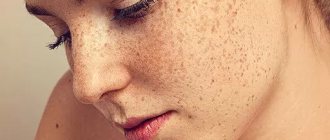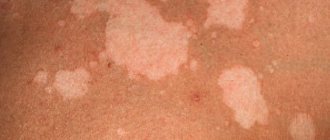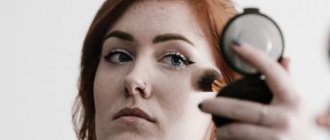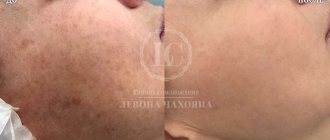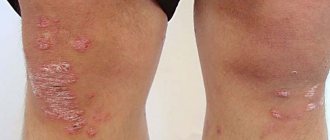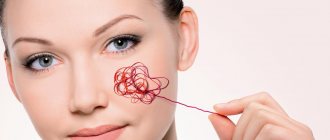A pleasant and uniform tan that does not evoke associations with charcoal shades, in most cases looks fresh and attractive. Golden-bronze tints on the skin transform the appearance, add notes of freshness and youth to it and, moreover, mask minor defects in the microrelief of the dermis. But achieving the ideal shade is not as easy as it seems at first glance: even meticulous skin care before and after tanning in a solarium and in the sun does not guarantee a 100% result - in some cases it is unrealistic to overcome genetics and body characteristics.
Sunbathe with caution
The appearance of white spots on the skin after sun exposure is one of the fairly common problems faced by lovers of sunbathing and ultraviolet cabins. What is the cause of such a defect, is it dangerous to health and what can be done to restore aesthetic perfection to the skin tone? Advice from experienced dermatologists and beauty experts will help you understand the features of such an anomaly.
Causes of age spots
1. Total dose of ultraviolet rays received over a lifetime
Histological studies of skin sections have shown that a person receives and accumulates 50% of the damage to skin structures by the age of 18.
Clinical manifestations of these injuries occur by the age of 25–30 years. This suggests that in childhood and adolescence, sunscreens were not used and there was no competent control of a person’s exposure to open sunlight. The process is aggravated by the fact that children's skin has an incompetent melanocyte system that does not function fully. Children's skin has little protection against the aggression of UV rays.
2. Sunburn
It has a traumatic effect on human skin and requires adequate restorative treatment. Otherwise, the risk of disruption of melanocyte function and the appearance of pigment spots increases.
It has been proven that for persistent pigmentation to appear, it is enough to get sunburned three times, i.e. "get sunburned."
In young people and children, sunburn is not perceived as something serious, the skin is restored relatively quickly externally, and internal damage is not visible to the naked eye.
Cellular disorders and breakdowns accumulate, manifestations occur after 30 years of early aging - the appearance of wrinkles, dry skin and age spots. These are manifestations of photoaging, which occurs not only in residents of sunny regions.
In the future, it will be enough to be exposed to the sun's rays for a short time and pigment spots will reappear on the skin.
How to treat sun allergy?
- The first thing to do is get out of the sun and wash off everything that was applied before. It is better to use soap intended for moisturizing the skin, which is sold in pharmacies; it is white and odorless.
- The second step, if there is no visible improvement, is to use an antiallergic drug.
It is necessary to drink a lot of fluid - 50 ml per kilogram of body weight per day, in order to remove metabolic products from the body that caused the reaction. If the allergic reaction worsens, an IV is given.
“An allergic reaction may go away on the same day, but if it appears a second time, the course will be worse. Therefore, it is necessary to follow general recommendations - do not be in the sun from 12:00 to 17:00; on the beach, hide from direct sunlight under awnings and umbrellas. Many people who are allergic to the sun can live a full life - swim, be in the sun, but for a limited amount of time,” concluded Nadezhda Magarina.
Source: healthy-kids.ru
Factors that provoke the occurrence of pigmentation
The main provocateur of pigmentation, among other disorders, is solar radiation . Under the influence of UV rays, the synthesis of melanocrine is induced - a hormone of the pituitary gland, which activates the work of pigment cells. The main contributing factors are:
- Genetic predisposition – dark skin color. People with genetically more melanocytes are more likely to develop pigmentation
- Hormonal disorders (pregnancy, endocrine diseases, taking hormonal drugs)
- Excess free radicals
The combination of an excessive amount of ultraviolet radiation with one of two predisposing factors equals the appearance of age spots.
What to do to prevent age spots from appearing
Prevention scheme:
Antioxidant preparations
Why we shouldn’t forget about the effects of free radicals: pigment cells also react to their excess by increasing melanin production.
Causes of excess free radicals:
- age over 30-35 years
- solar radiation
- bad ecology
- dietary violations, etc.
Residents of megacities and hot sunny regions experience a special load of free radicals, and therefore their own antioxidant defense system is depleted ahead of time and cannot cope.
Lightening agents
Starting in early spring, the use of agents that normalize and balance the work of melanocytes. These are non-aggressive lightening agents that do not thin the skin or increase sensitivity.
Example: DermaQuest SkinBright lightening line is designed specifically to work with pigmentation of any severity. Combined formulations and the absence of aggressive and dangerous ingredients make therapy not only effective, but also comfortable.
DermaQuest SkinBright serum and cream are a combination that enhances each other’s effectiveness. Advantages:
- rich composition of safe brightening ingredients
- do not require additional skin care products
- moisturize, nourish, have an antioxidant effect
- prevention of age-related changes
Contains:
- Stem cells of Lily Snow White
- Melanostatin-5 (brightening peptide)
- Chromebright
- Bakuchiol A (Vitimon A simulator without the irritating effects of retinoids)
- Hexylresorcinol – 4 times more active than hydroquinone in lightening effect
- Emblica – plant extract
- Kojic acid dipalmitate
- Bearberry, licorice root and white mulberry extract
- Arbutin
- SkinBright preparations do not contain Hydroquinone!
They do not have an irritating effect, have a moisturizing and nourishing effect, making them a complete treatment used morning and evening for the entire face.
There is no need for local application and the purchase of additional care products!
How to whiten your face from tanning at home
But what to do if you are already burned? Most often, many of us try to whiten our faces from tanning at home. Let’s say right away that it’s not so easy to remove the tan from your face if you’re burned to the point of blisters.
. Actually, in this case, you should not be concerned about evening out your complexion, since this requires special measures (it is best to consult a doctor).
via GIPHY
It's another matter if the face, as they say, has become stained. , characteristic redness is observed on the surface of the skin of the face.
, which you can try to cope with at home, if you use ordinary means available in almost any house or apartment.
However, you should understand what you want to do: remove the redness of the face after tanning (that is, immediately after tanning!) or get rid of a tan on the face, which can be called old or persistent
. Let's start the review with the simplest remedy that will help cope with fresh, minor redness - water!
Water
Beneficial features:
Water is not only the most accessible remedy for sunburn, but also, in fact, the primary remedy. Its main task is to normalize heat exchange and “even out” the temperature in different areas of the skin.
How to use water for sunburn:
Yes, you can call a tan a sunburn without any embarrassment, since that is essentially what it is. To normalize heat exchange, you just need to lower your face into the water. The water should not be icy, but just cool.
You can also use cold compresses. Frequency of action - until pain decreases and complexion evens out. Usually the redness subsides in about an hour or less (in simple cases)
. And God forbid you use ice for prolonged cooling of burnt areas - you will only worsen the situation, as this can lead to the death of the epithelium.
Dairy
Beneficial features:
Even children, it seems, know about the beneficial properties of sour cream, whey or kefir applied to areas of skin burnt after sunbathing. However, no one can really say what causes them.
In fact, if we are talking about a severe sunburn, then dairy products will do more harm than good! For moderate burns, sour cream or kefir provide sufficient skin hydration
, increasing its elasticity. The difference from water is that sour cream stays on the body better and takes longer to heat up!
How to use dairy products:
firstly, if you have dry skin, then you should use sour cream; for oilier skin, kefir (even low-fat) or the same serum is suitable. Secondly, you should apply a thin layer of the dairy product to the reddened areas of the body, wait until the itching and redness goes away, then rinse with cool water.
Aloe juice
Beneficial features:
Aloe juice is considered a reliable remedy that is highly effective in treating not only small cuts or wounds, but also in the treatment of skin diseases. Sunburns begin to bother you less, and dark areas of the skin become somewhat lighter.
How to use aloe juice for sunburn:
cut off the aloe leaves, wash them thoroughly, chop and squeeze out the juice. After this, you need to spread the resulting paste onto the damaged (reddened) areas of the skin on the face, leaving them for literally a couple of hours. You can cool it a little beforehand.
Parsley
Beneficial features:
Parsley is a well-known antioxidant that has a beneficial effect on the skin, preventing it from aging. By the way, since our skin is regularly (to varying degrees) exposed to ultraviolet rays, it is recommended to use parsley on a regular basis.
How to use parsley for sunburn:
There are several methods available. Firstly, finely chopped parsley can be mixed, for example, with sour cream, and then spread in a thin layer on the burnt area. Secondly, you can treat your face with an infusion of fresh or dried herbs.
Finally, if you make ice cubes from the parsley infusion, you can rub them on your skin (but remember not to let the ice sit on the burned areas for too long).
Lemon juice
Beneficial features:
Lemon juice has a number of well-known beneficial properties that allow it to be used not only to lighten tanned skin. Lemon juice is a constant ingredient in various scrubs and masks to brighten and even out complexion.
How to use lemon juice for sunburn:
Let's start with the fact that lemon juice cannot be used to remove fresh redness that occurs immediately after sunbathing. In the case of sensitive skin, this is even dangerous! In this situation, it is recommended to dilute lemon juice with cucumber juice, mineral water or another component.
Treat your skin with nourishing cream
If you have normal or oily skin, you can apply a slice of lemon to your face several times a day (4-5 times), leaving the juice on your face
within five to ten minutes. After this, you need to wash your skin with warm water (if the juice is very diluted, you don’t have to wash it off). It is recommended to apply a thin layer of nourishing cream to the treated skin.
Vinegar
Beneficial features:
vinegar allows you to effectively even out your complexion, evenly removing tan and spots formed by improper tanning. Obviously, such an active agent as vinegar must be used to remove old tan, since it is unacceptable to apply a vinegar solution to the skin immediately after a sunburn.
How to use vinegar against tanning:
Besides the fact that vinegar is not used to normalize the situation on skin that has just been sunburned by ultraviolet radiation, it is also not recommended for use on sensitive skin.
In any case, vinegar is usually diluted with water in equal proportions. a cotton pad soaked in the solution.
, taking the longest to process particularly dark areas. Then leave the resulting layer for 15 minutes, then rinse it off with warm water.
Hydrogen peroxide
Beneficial features:
Probably the most effective bleaching agent that allows you to quickly remove tan from your face at home is
hydrogen peroxide
. However, it is also the most dangerous remedy in terms of possible undesirable consequences, so it is often recommended to consult cosmetologists for skin peeling using peroxide.
How to use vinegar against tanning:
In order not to completely burn the skin, it is recommended to use peroxide to remove tan, depending on your skin type -
dry, normal, oily
. Don't use peroxide more than once a week if you have dry skin. Obviously, peroxide is not particularly suitable for quickly and safely removing tan from the face with dry skin.
For oily skin, you can treat your face with peroxide no more than twice a week. In this case, the solution should be three percent - no more! You can also use various masks based on hydrogen peroxide
, however, they should also be selected and manufactured based on the recommendations of professionals who take into account your skin type.
